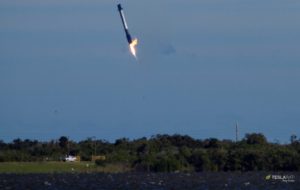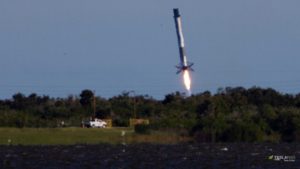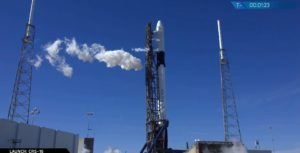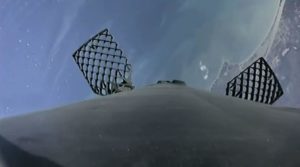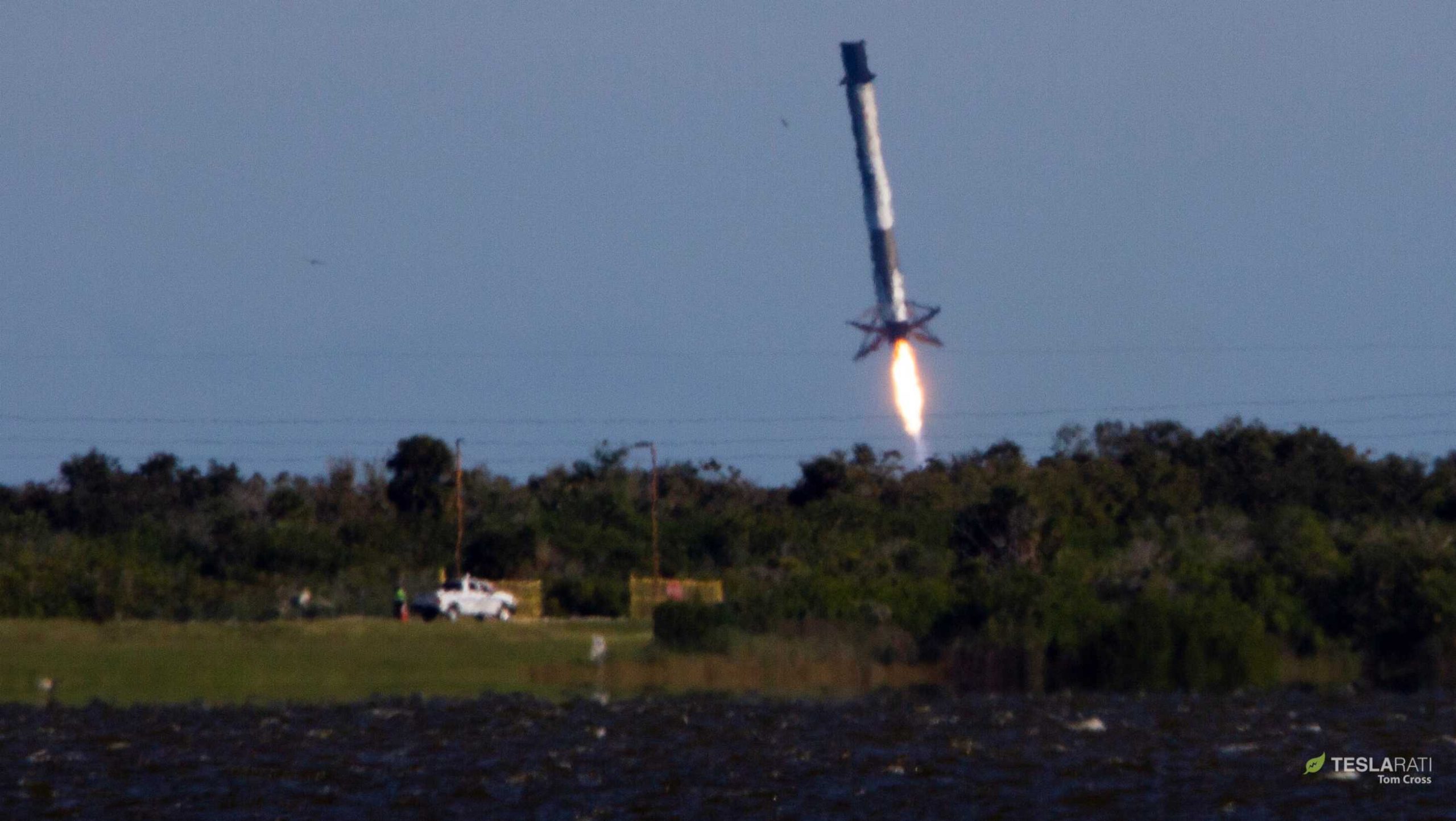
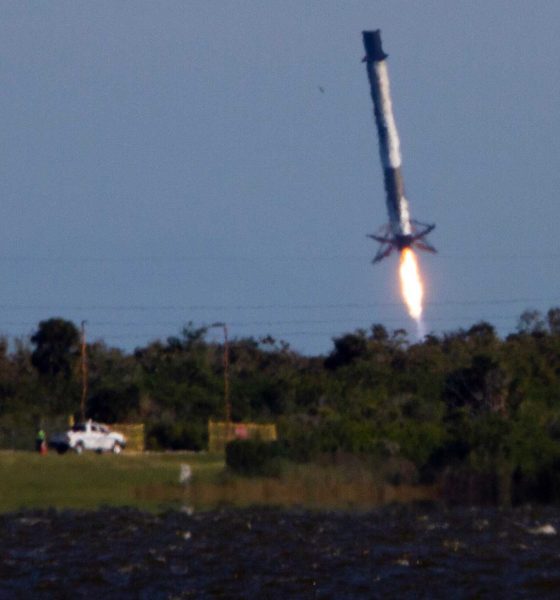
News
SpaceX’s first Falcon 9 Block 5 landing failure caught on video after launch success
In an extraordinary bit of live footage, SpaceX’s first Falcon 9 Block 5 launch of the Cargo Dragon spacecraft was topped by a spectacular partial failure of the Block 5 booster during its attempted recovery at Landing Zone-1 (LZ-1).
Despite this off-nominal recovery, Falcon 9 successfully placed Cargo Dragon into what John Insprucker deemed a highly accurate orbit, leaving the spacecraft to make its way to the International Space Station between now and Saturday. CEO Elon Musk further noted that Falcon 9 B1050 – despite landing in the ocean – was intact and still transmitting telemetry, potentially allowing SpaceX to still recovery the forlorn rocket.
Absolutely wild on-the-ground footage of @spacex Falcon 9 B1050's partially failed recovery, courtesy of Twitch streamer DasValdez. Keep in mind, of course, that the main mission – launching Cargo Dragon to orbit – was fully successful. pic.twitter.com/fKq7T79oIH
— Eric Ralph (@13ericralph31) December 5, 2018
What exactly went wrong is entirely unclear but roughly 30 seconds before a planned landing at LZ-1, Falcon 9 B1050 – shown live on SpaceX’s webcast – began to spin at an increasingly rapid pace, visibly losing some of its aerodynamic control authority before SpaceX cut the live feed. In the background, viewers could still hear the team on-console making callouts as the rocket’s landing burn started, culminating in a call for the landing team to “move to contingency procedure[s]”, the only SpaceX affirmation that something went wrong.
Above all else, it’s important to remember that the primary mission – sending Cargo Dragon to the ISS – continues to proceed nominally. In other words, Falcon 9 performed fine during ascent and only exhibited off-nominal behavior during the booster’s attempted landing after separating from the upper stage and Dragon payload.
- Despite major problems, Falcon 9 somehow pulled off a successful soft-landing in the Atlantic. (Tom Cross)
- Falcon 9 B1050 fought til the end, coming to a shockingly soft landing despite spinning rapidly. (Tom Cross)
- CRS-16 one minute before launch. (SpaceX)
- Falcon 9 B1050 seen shortly before a grid fin lost control, throwing the rocket into a near-uncontrollable spin. (SpaceX)
CEO Elon Musk took to Twitter soon after the breathtaking loss of control and expected landing time, stating that the SpaceX team currently pegged the failure on a grid fin’s stalled hydraulic fin, which ultimately caused the wild spinning seen in the webcast. Although it is almost without a doubt too early to actually know if the booster is in good enough condition to ever fly again, Musk seemed to directly suggest that it could eventually relaunch in support of an “internal SpaceX mission”, basically either Starlink or tech development.
Grid fin hydraulic pump stalled, so Falcon landed just out to sea. Appears to be undamaged & is transmitting data. Recovery ship dispatched.
— Elon Musk (@elonmusk) December 5, 2018
Stay tuned as SpaceX and Musk continue to offer updates on the continuing Cargo Dragon mission and attempted Falcon 9 recovery. SpaceX’s webcast recap can be viewed below.
For prompt updates, on-the-ground perspectives, and unique glimpses of SpaceX’s rocket recovery fleet check out our brand new LaunchPad and LandingZone newsletters!

News
Tesla FSD fleet is nearing 7 billion total miles, including 2.5 billion city miles
As can be seen on Tesla’s official FSD webpage, vehicles equipped with the system have now navigated over 6.99 billion miles.

Tesla’s Full Self-Driving (Supervised) fleet is closing in on almost 7 billion total miles driven, as per data posted by the company on its official FSD webpage.
These figures hint at the massive scale of data fueling Tesla’s rapid FSD improvements, which have been quite notable as of late.
FSD mileage milestones
As can be seen on Tesla’s official FSD webpage, vehicles equipped with the system have now navigated over 6.99 billion miles. Tesla owner and avid FSD tester Whole Mars Catalog also shared a screenshot indicating that from the nearly 7 billion miles traveled by the FSD fleet, more than 2.5 billion miles were driven inside cities.
City miles are particularly valuable for complex urban scenarios like unprotected turns, pedestrian interactions, and traffic lights. This is also the difference-maker for FSD, as only complex solutions, such as Waymo’s self-driving taxis, operate similarly on inner-city streets. And even then, incidents such as the San Francisco blackouts have proven challenging for sensor-rich vehicles like Waymos.
Tesla’s data edge
Tesla has a number of advantages in the autonomous vehicle sector, one of which is the size of its fleet and the number of vehicles training FSD on real-world roads. Tesla’s nearly 7 billion FSD miles then allow the company to roll out updates that make its vehicles behave like they are being driven by experienced drivers, even if they are operating on their own.
So notable are Tesla’s improvements to FSD that NVIDIA Director of Robotics Jim Fan, after experiencing FSD v14, noted that the system is the first AI that passes what he described as a “Physical Turing Test.”
“Despite knowing exactly how robot learning works, I still find it magical watching the steering wheel turn by itself. First it feels surreal, next it becomes routine. Then, like the smartphone, taking it away actively hurts. This is how humanity gets rewired and glued to god-like technologies,” Fan wrote in a post on X.
News
Tesla starts showing how FSD will change lives in Europe
Local officials tested the system on narrow country roads and were impressed by FSD’s smooth, human-like driving, with some calling the service a game-changer for everyday life in areas that are far from urban centers.

Tesla has launched Europe’s first public shuttle service using Full Self-Driving (Supervised) in the rural Eifelkreis Bitburg-Prüm region of Germany, demonstrating how the technology can restore independence and mobility for people who struggle with limited transport options.
Local officials tested the system on narrow country roads and were impressed by FSD’s smooth, human-like driving, with some calling the service a game-changer for everyday life in areas that are far from urban centers.
Officials see real impact on rural residents
Arzfeld Mayor Johannes Kuhl and District Administrator Andreas Kruppert personally tested the Tesla shuttle service. This allowed them to see just how well FSD navigated winding lanes and rural roads confidently. Kruppert said, “Autonomous driving sounds like science fiction to many, but we simply see here that it works totally well in rural regions too.” Kuhl, for his part, also noted that FSD “feels like a very experienced driver.”
The pilot complements the area’s “Citizen Bus” program, which provides on-demand rides for elderly residents who can no longer drive themselves. Tesla Europe shared a video of a demonstration of the service, highlighting how FSD gives people their freedom back, even in places where public transport is not as prevalent.
What the Ministry for Economic Affairs and Transport says
Rhineland-Palatinate’s Minister Daniela Schmitt supported the project, praising the collaboration that made this “first of its kind in Europe” possible. As per the ministry, the rural rollout for the service shows FSD’s potential beyond major cities, and it delivers tangible benefits like grocery runs, doctor visits, and social connections for isolated residents.
“Reliable and flexible mobility is especially vital in rural areas. With the launch of a shuttle service using self-driving vehicles (FSD supervised) by Tesla in the Eifelkreis Bitburg-Prüm, an innovative pilot project is now getting underway that complements local community bus services. It is the first project of its kind in Europe.
“The result is a real gain for rural mobility: greater accessibility, more flexibility and tangible benefits for everyday life. A strong signal for innovation, cooperation and future-oriented mobility beyond urban centers,” the ministry wrote in a LinkedIn post.
News
Tesla China quietly posts Robotaxi-related job listing
Tesla China is currently seeking a Low Voltage Electrical Engineer to work on circuit board design for the company’s autonomous vehicles.

Tesla has posted a new job listing in Shanghai explicitly tied to its Robotaxi program, fueling speculation that the company is preparing to launch its dedicated autonomous ride-hailing service in China.
As noted in the listing, Tesla China is currently seeking a Low Voltage Electrical Engineer to work on circuit board design for the company’s autonomous vehicles.
Robotaxi-specific role
The listing, which was shared on social media platform X by industry watcher @tslaming, suggested that Tesla China is looking to fill the role urgently. The job listing itself specifically mentions that the person hired for the role will be working on the Low Voltage Hardware team, which would design the circuit boards that would serve as the nervous system of the Robotaxi.
Key tasks for the role, as indicated in the job listing, include collaboration with PCB layout, firmware, mechanical, program management, and validation teams, among other responsibilities. The role is based in Shanghai.
China Robotaxi launch
China represents a massive potential market for robotaxis, with its dense urban centers and supportive policies in select cities. Tesla has limited permission to roll out FSD in the country, though despite this, its vehicles have been hailed as among the best in the market when it comes to autonomous features. So far, at least, it appears that China supports Tesla’s FSD and Robotaxi rollout.
This was hinted at in November, when Tesla brought the Cybercab to the 8th China International Import Expo (CIIE) in Shanghai, marking the first time that the autonomous two-seater was brought to the Asia-Pacific region. The vehicle, despite not having a release date in China, received a significant amount of interest among the event’s attendees.
